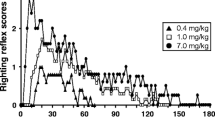Summary
Mice administered haloperidol 3 mg/kg/day in their drinking water for 21 days were tested for their locomotor responsiveness to saline or acid vehicle,dl-, l- ord-propranolol, metoprolol, butoxamine or practolol. Haloperidol-treated animals administered saline or acid-vehicle were, in five of six experiments, more active than animals withdrawn from vehicletreatment. Haloperidol- and vehicle-treated animals responded differently to the non-selectiveβ-adrenoreceptor antagonists (dl-propranolol andl-propranolol) and selectiveβ 1-adrenoreceptor antagonists (practolol and metoprolol), but not to a selectiveβ 2-adrenoreceptor antagonist (butoxamine). Withdl-propranolol (4 mg/kg) the locomotor activity of halo-peridol-treated animals was significantly (0.01<P<0.02) greater than that of the vehicle-treated animals. Similar effects in the same direction were seen withl-propranolol (1 mg/kg, 0.005<P<0.01), practolol (10 and 100 mg/kg, 0.025<P<0.05 and 0.01<P<0.025 respectively) and metoprolol (8 mg/kg, 0.005<P<0.01). Thed-isomer of propranolol which is about 50 times less active as aβ-adrenoreceptor antagonist than thel-isomer, although having equal membrane stabilizing effects, did not differentially affect haloperidol- or vehicle-treated groups. The results suggest that there has been a change inβ 1-adrenoreceptor responsiveness in animals withdrawn from long-term haloperidol treatment.
Similar content being viewed by others
References
Alexander, R. W., Davis, J. N., Lefkowitz, R. J. Direct identification and characterization ofβ-adrenergic receptors in rat brain. Nature258, 437–440 (1975).
Atsmon, A., Blum, L., Steiner, M., Latz, A., Wijsenbeek, H. Further studies with propranolol in psychotic patients. Psychopharmacol.27, 249–254 (1972).
Barrett, A. M., Cullum, V. A. The biological properties of the optical isomers of propranolol and their effects on cardiac arrhythmias. Brit. J. Pharmacol.34, 43–55 (1968).
Delini-Stula, A., Meier, M. Inhibitory effects of propranolol and oxprenolol on excitation produced by a MAO inhibitor and reserpine in the mouse. Neuropharmacol.15, 383–388 (1976).
Dollery, C. T., Lewis, P. J. Central hypotensive effect of propranolol. Postgrad. Med. J.52, 116–120 (1976).
Dunlop, D., Shanks, R. G. Selective blockade of adrenoceptive beta-receptors in the heart. Brit. J. Pharmacol.32, 201–218 (1968).
Dunstan, R., Jackson, D. M. The demonstration of a change in adrenergic receptor sensitivity in the central nervous system of mice after withdrawal from long-term treatment with haloperidol. Psychopharmacol.48, 105–114 (1976).
Dunstan, R., Jackson, D. M. The effect of apomorphine and clonidine on locomotor activity in mice after long-term treatment with haloperidol. Clin. & Exp. Pharmacol. Physiol.4, 131–141 (1977 a).
Dunstan, R., Jackson, D. M. The demonstration of a change in responsiveness of mice to physostigmine after withdrawal from long-term haloperidol pretreatment. J. Neural Transm.40, 181–189 (1977 b).
Engel, J., Liljeqvist, S., Johannessen, K. Behavioural effects of long-term treatment with antipsychotic drugs. In: Antipsychotic Drugs, Pharmaco-dynamics and Pharmacokinetics (Zotterman, Y., Uvnäs, B., Sedvall, G., eds.), pp. 63–71. New York: Pergamon Press. 1976.
Estler, C.-J., Ammon, H. P. T. Absence of central nervous system effects of practolol [ici 50, 172; 4-(2-hydroxy-3-isopropylaminopropoxy)-acetanilide], a new adrenergicβ-receptor blocking drug. J. Pharm. Pharmacol.21, 554–555 (1969).
Estler, C.-J., Amman, H. P. T. Modification by two beta-adrenergic blocking drugs of the effects of methamphetamine on behaviour and brain metabolism of mice. J. Neurochem.18, 777–779 (1971).
Fitzgerald, J. D. Perspectives in adrenergic beta-receptor blockade. Clin. Pharmacol. and Ther.10, 292–297 (1969).
Greenblatt, D. J., Shader, R. I. On the psychopharmacology of beta-adrenergic blockade. Current Ther. Res.14, 615–625 (1972).
Herman, Z. S. Influence of some psychotropic and adrenergic blocking agents upon amphetamine stereotyped behaviour in white rats. Psycho-pharmacologia (Berl.)11, 136–142 (1967).
Jackson, D. M., Dunstan, R., Bracs, P. U. Pharmacological models in tardive dyskinesia: a role for dopamine and noradrenaline. In: Symposium on Drugs and Society (Johnson, G. F. S., ed.), pp. 13–21. Sydney: Ciba-Geigy. 1976.
Leszkovszky, G., Tardos, L. Some effects of propranolol on the central nervous system. J. Pharm. Pharmacol.17, 518–520 (1965).
Mantegazza, P., Naimzada, K. M., Riva, M. Effects of propranolol on some activities of amphetamine. Eur. J. Pharmacol.4, 25–30 (1968).
Melamed, E., Lahav, M., Atlas, D. Direct localization ofβ-adrenoceptor sites in rat cerebellum by a new fluorescent analogue of propranolol. Nature261, 420–422 (1976).
Scales, B., Cosgrove, M. B. The metabolism and distribution of the selective adrenergic beta blocking agent, practolol. J. Pharmacol. exp. Ther.175, 338–347 (1970).
Shah, U. H., Jindal, M. N., Patel, V. K., Kelbar, V. U. Central actions of someβ-adrenoceptor blocking agents. Arzneim.-Forsch.24, 1581–1584 (1974).
Shanks, R. G. The peripheral vascular effects of propranolol and related compounds. Brit. J. Pharmacol. Chemother.29, 204–217 (1967).
Shanks, R. G. The properties of beta-adrenoceptor antagonists. Postgrad. Med. J.52, suppl. 4, 14–20 (1976).
Svensson, T. H., Thieme, G. An investigation of a new instrument to measure motor activity of small animals. Psychopharmacologia (Berl.)14, 157–163 (1969).
Tarsy, D., Baldessarini, R. J. Behavioural supersensitivity to apomorphine following chronic treatment with drugs which interfere with the synaptic function of catecholamines. Neuropharmacol.13, 927–940 (1974).
Wasserman, M. A., Levy, B. Selective beta adrenergic receptor antagonism in the anaesthetized dog. J. Pharmacol. exp. Ther.188, 357–367 (1974).
Āblad, B., Borg, K.-O., Carlsson, E., Johnsson, G., Malmfors, T., Regårdh, C.-G. Animal and human pharmacological studies on metoprolol-a new selective adrenergicβ 1-receptor antagonist. Acta pharmacol. et toxicol.36, 1–144 (1975).
Author information
Authors and Affiliations
Rights and permissions
About this article
Cite this article
Dunstan, R., Jackson, D.M. Long-term haloperidol-treatment of mice: A change in β-adrenergic receptor responsiveness. J. Neural Transmission 44, 187–195 (1979). https://doi.org/10.1007/BF01253062
Received:
Issue Date:
DOI: https://doi.org/10.1007/BF01253062



